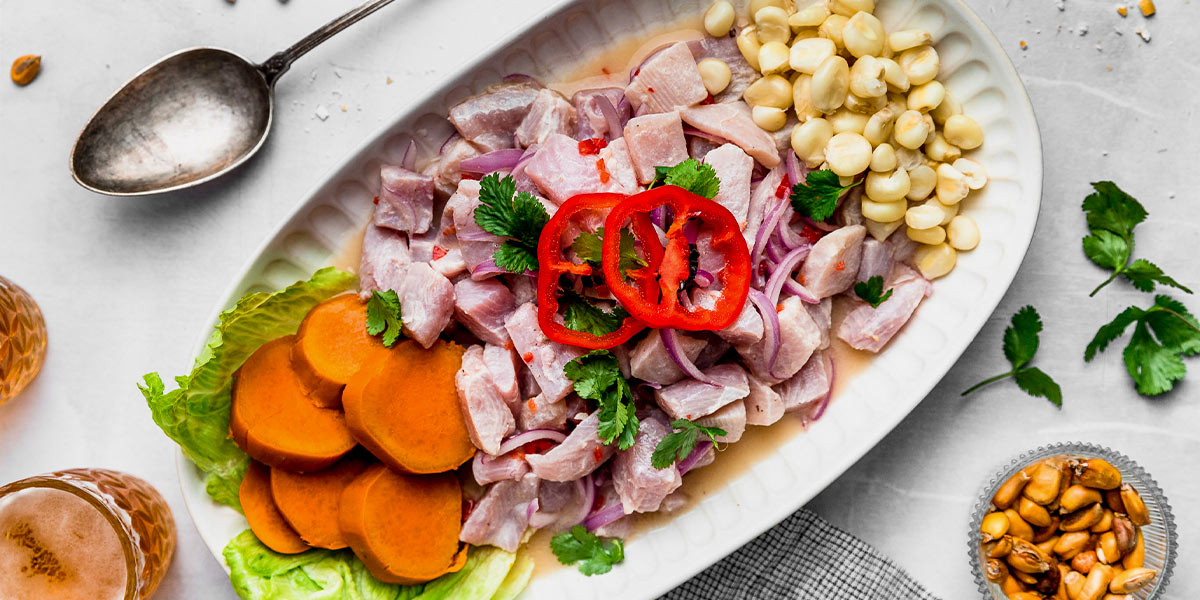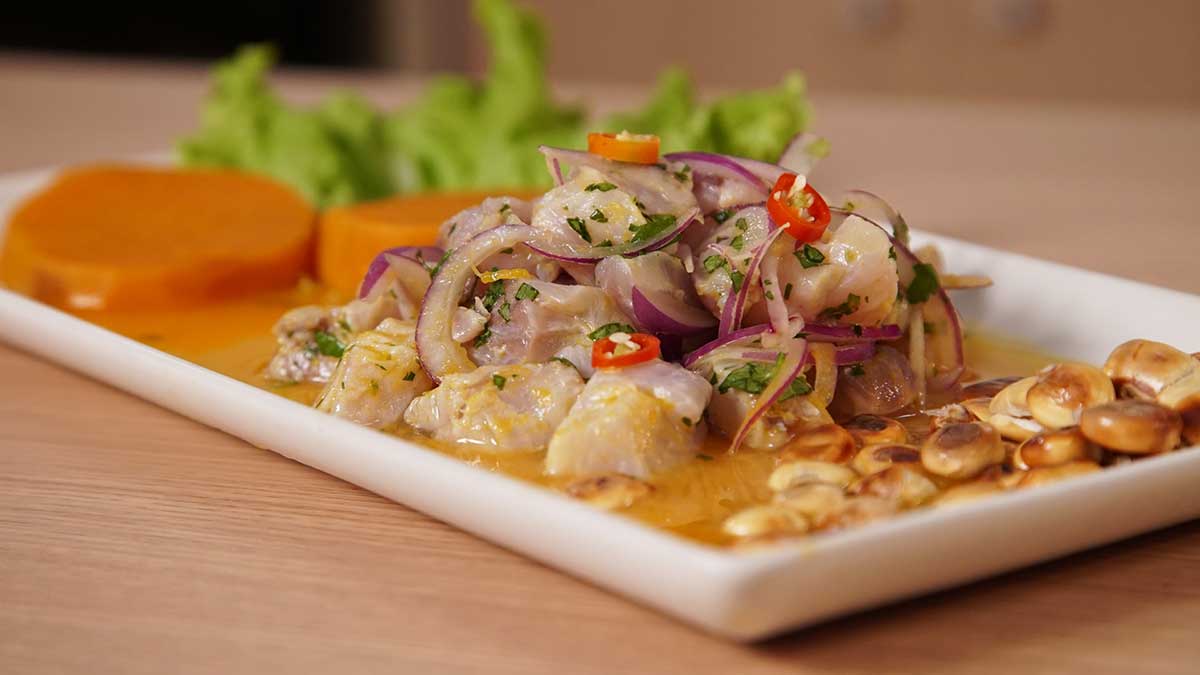
Ceviche, which is often spelled ceviche or seviche, depending on what part of South America it comes from, is basically raw fish and seafood marinated in citrus juice, mainly lemon juice. According to the Peruvian historian Javier Pulgar Vidal, the ceviche name comes from the Quechua word "Siwichi" which would mean fresh fish or tender fish.
One hypothesis proposes that the words Siwichi and Sikba were confused during the conquest of the Inca Empire by the Spaniards, which caused that it was transformed into the name with which we know it today. The dish is served in a type of restaurant known as cevicheria. The juice citrus coagulates the proteins of the fish, effectively cooking it, thus not heating it, and it is served cold or at room temperature. Many fish and shellfish are used to prepare it.
The most popular fish that are used to prepare the ceviche are the Snapper, the Corvina, the Grouper and the Dorado. Other ingredients of the marine food are prawns, shells, squid and octopus. It can be eaten as an entree or as a main dish, depending on how it is served. It seems that there are as many varieties of ceviche as the people who eat it. Continue reading and discover all about the famous dish of Peru Ceviche:
Ceviche could have originated among the Moche, a coastal civilization that began to flourish in the area that is currently northern Peru almost 2000 years ago. The Moche apparently used the fermented juice of banana and passion fruit. Recent research also shows, during the Inca Empire, that the fish were marinated with chicha, an Andean fermented drink. Different chronicles also report that along the Peruvian coast before the arrival of Europeans, the fish was consumed with salt and "chili". On the other hand, this theory proposes that the natives simply changed for the citrus brought by the Spanish colonizers, but the main concepts of the dish remain essentially the same.

The basic ingredients of any Ceviche in Peru are:
500 g fresh white fish (corvina, sole, or grouper)
1 cup fresh lime juice
1 red onion, finely julienned
1 ají limo (or ají amarillo), deseeded and chopped
1 sprig fresh cilantro, chopped
Salt and pepper to taste
1 cooked sweet potato, sliced
Cooked and shelled corn
Cancha (toasted corn) to accompany
Preparation of Peruvian Ceviche
1. Cut the fish into 1 to 2 cm cubes. Use it very fresh and keep it refrigerated until ready to use.
2. Place the fish in a bowl, add salt and pepper, and pour in the lime juice until covered. Then, mix carefully.
3. Let it rest for 10 to 15 minutes, depending on your preferred cooking point.
4. Then cut the onion and add it along with the chopped ají, and mix again.
5. Add the cilantro just before serving.
6. Serve immediately accompanied with sweet potato, corn, and cancha.
The ideal is for the fish used in ceviche Peru to be caught with a hook, as this keeps the meat firm and undamaged. To prepare it, it is mixed with the other ingredients and left to marinate to taste.
In Lima, the capital of Peru and the north of the country, ceviche is usually served instantly to prevent the lemon from cooking the fish too much. In contrast, in the south, especially in Arequipa, it is common to add chopped celery to the leche de tigre, the juice that results from mixing the fish with lemon, chili, and other ingredients. This juice is acidic, slightly spicy, and considered a good restorative.
In many areas, it is consumed as breakfast after a long night. A known variant is leche de pantera, dark in color, which is obtained from black shell ceviche. This type is prepared on the coast of Piura and Tumbes, and is also found in Central American Pacific, where there is even a version with white shell.
The Peruvian Ceviche is traditionally served on a flat plate (it is an entrance plate). However, in haute cuisine it has been seen served in wide glasses and very recently, sold in glasses in the streets as a snack. The garrisons considered vary from region to region.
In Lima, Chimbote and Trujillo the most common accompaniments are the corn, the field (toasted corn), sweet potato boiled in water and weed (Chondracanthus chamissoi) or lettuce leaves. More to the north, in Tumbes, Piura and Chiclayo it is usually accompanied with chifles (fried banana in slices) and zarandaja (Lablab purpureus), a species of legume from the area, originally from Africa. You can also see yucca boiled in water in both areas, as in Iquitos. The usual drink to accompany a ceviche is chicha de jora, black beer or an Inca Kola to appease the pleasant itch so typical of Peruvian food. It is also very popular to accompany it with a common cold beer.

Every June 28, Peru celebrates the National Ceviche Day, a date dedicated to one of the most representative dishes of its gastronomy. The initiative emerged in the 70s, when chef Gastón Acurio proposed establishing an official day to honor this traditional dish and strengthen its presence both inside and outside the country.
During this date, it is common to see gastronomic fairs and promotions in restaurants, where different versions of ceviche are offered: from the classic with white fish and lime juice, to mixed versions with seafood, octopus ceviche or even vegetarian alternatives with mushrooms.
Peruvian ceviche not only stands out for its fresh and balanced flavor, but also for its cultural value. It is part of the country's identity and one of the main ambassadors of Peruvian cuisine in the world.
Types of ceviche
The exact ingredients and preparation methods for ceviche can vary depending on the region and personal preferences. However, the basic process involves combining the raw seafood with citrus juice, along with other ingredients such as onions, tomatoes, cilantro, and chili peppers. The mixture is typically seasoned with salt and pepper, and sometimes additional spices or herbs.
Peru is a country full of contrasts: coast, highlands, and jungle offer unique routes for all those seeking adventure, history, and unforgettable landscapes. From cities full of heritage to surprising natural destinations, each region shows a different side of the country and leaves lasting memories. Here is a list of the best tours you can take on your trip through the country: